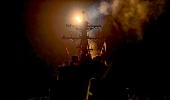The world needs to wake up to this new dimension of war at sea and be prepared to face the 'unknown enemy' who have the advantage of attacking at their choice of location and time, cautions Commodore Venugopal Menon (retd).
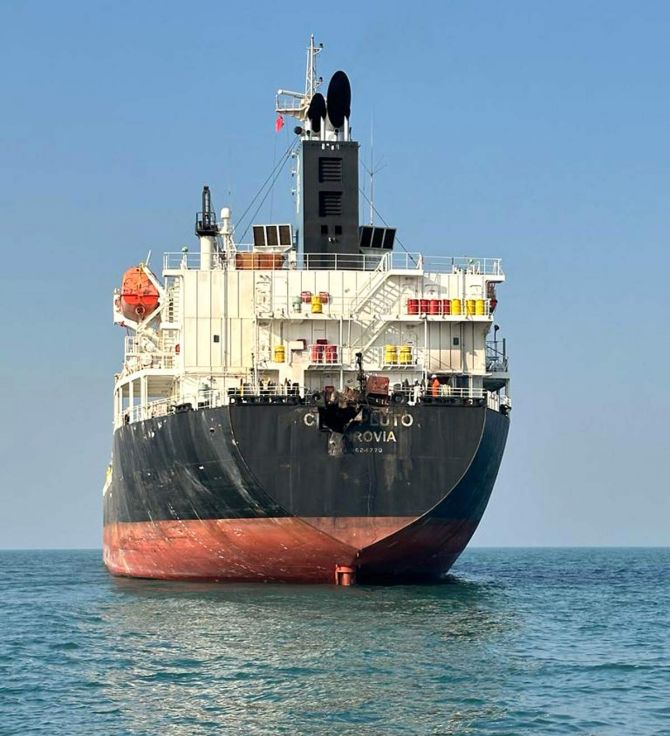
Recent incidents of drone and missile attacks, hijacking of ships by Houthis and pirates have opened a Pandora's box of asymmetric warfare at sea.
In effect, it is the roll over of the Israel Hamas war to the maritime domain.
The repercussion of such a warfare is huge when it affects a busy shipping lane which connects Europe to South Asia, South East Asia, and the Far East.
The Red Sea connects Asia and Europe via the Suez Canal which handles nearly 12% of the global trade with large ships carrying cargo right from electronic goods to machinery, oil and gas, raw materials, to automobiles.
In 2023 approximately 22% of global seaborne container trade passed through this sea route.
The Suez Canal/Red Sea enables a more direct route for shipping between Europe and Asia without having to circumnavigate the African continent.
The route via the Red Sea is significantly shorter as compared to the route via Cape of Good Hope by about 3,500 nautical miles, thus saving on fuel and time which indirectly affects the shipping costs.
Disruption of smooth transit of oil and gas by sea route affects the energy security of countries in South Asia, South East Asia and the Far East, thereby severely affecting their economy.
The Threat
The Iran backed Houthi outfit which controls large parts of Yemen has attacked numerous commercial ships in the Red Sea since mid-November 2023 in solidarity with the Palestinian cause in the Israel-Hamas conflict.
They have resorted to missile/drone attacks and hijacking of vessels.
Concurrently, Somali pirates and other terrorist groups in the region like Al Shabab have also revived their attacks on commercial ships.
There is no clear evidence of any link or coordination between the Somali pirates, Al Shabab and the Houthis other than the fact that all are renegade groups or militias.
This complex situation poses a significant maritime threat to the region and has led to an escalation of tensions in the Middle East.

Asymmetric Warfare
The threats can be classified as part of an asymmetric warfare which essentially is warfare between opposing forces differing greatly in military power and that typically involves the use of unconventional weapons and tactics which is generally associated with guerilla warfare and terrorism/insurgency.
Further, the combatants are not regular military forces of nation States and are generally referred to as 'Non State actors'.
This type of warfare is mostly funded by the State or vested interests directly or indirectly through proxies in support of the outfit's nocturnal cause and objectives.
Funding is the basic tenet that keeps any illegal movement active. Gun running, narcotics smuggling and human trafficking are other sources of income for these groups.
Threat Dimension
The Iran-backed Houthis are the main group in the region who is responsible for making the Red Sea as a security hotspot.
Due to lack of an effective central government in Somalia and Yemen, other non-State actors viz Al Hirak in Yemen, Somalia's Al Shabab, Ansar al Sharia and the pirates controlled by various syndicates are the other groups responsible for the attacks on shipping.
Other major security challenges facing the region are the ongoing wars and tensions between and within each country.
These include the affiliation of the Red Sea islands, border disputes, territorial claims, conflicting economic interests, ideological differences, and ethnic divisions which add complexity to the security paradigm in the region.
Due to its transit point and proximity to conflict zones, the Red Sea is one of the areas with the highest concentration of arms and human traffickers.
Nature of Threats
The threat is predominantly surface and air, but a future underwater threat cannot be ruled out as Iran has a huge stockpile of sea mines.
However, there are unconfirmed reports that the Houthis had employed an underwater drone to target civilian ships signaling a new capability.
Another possibility is that the Houthis have successfully deployed Semi-Submersible explosive Device (IED) resembling a torpedo which is also unverified.
In addition to the attacks on ships, there are suspicions of the Houthis' involvement in damaging submarine communication cables and other critical underwater infrastructure.
Due to advancement of technology and its subversive applications, the concept of cyber warfare in future also cannot be ruled out.
In short, the region must be prepared to counter multi-dimensional threats from piracy, missiles, submersibles, drone strikes and possibly cyber threats in the future which makes the situation more complex.
Hence the overall aim should be to counter the security challenges in the region conventionally, asymmetrically, and technologically.
Future concepts of operations (CONOPS) to tackle the security concerns need to factor in the different challenges.
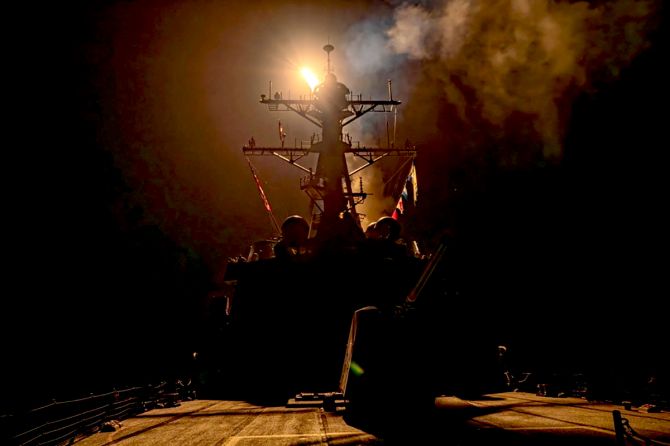
Global Reaction
The United States launched an international operation in the Red Sea viz Operation Prosperity Guardian in December 2023 to protect the commercial ships and keep the vital sea lanes open.
The International Maritime Security Force has more than 20 members which includes countries like India who support the operation independently.
This operation aims to ensure the freedom of navigation and the safety of maritime traffic in the Red Sea, Bab al Mandeb, and the Gulf of Aden.
Command and Control of Operation Prosperity Guardian
This operation is under the control of Combined Task Force (CTF) 153 which includes the US Carrier Strike Group and supported by destroyers/frigates/personnel from participating countries.
CTF 153 is part of the Combined Maritime Forces (CMF) which was established in 2001.
Shore coordination is done by the CMF headquarters at Bahrain. The current missions that support the overall aim include the following:
- Operation Atlanta set up by the European Union Naval Force (EUNAVFOUR) which operates off the Horn of Africa and in the Western Indian Ocean to protect shipping from piracy with its headquarters in Spain. This Operation aims to guarantee freedom of navigation in the Strait of Hormuz.
- The European Union launched Operation Aspides in February 2024 to protect cargo ships in the Red Sea from attacks by Houthi rebels. This naval mission deploys European warships and airborne early warning systems to the Red Sea, Gulf of Aden, and surrounding waters. This mission is operating under the Operational Command Centre at Larissa, Greece.
- Besides these forces there are countries Viz China and India which do not form part of any task group but operate independently under the control of their respective Head quarters in support of the overall aim.
Countermeasures By Commercial Ships
Surface Attacks
Commercial ships have experienced attacks by pirates/Houthis/fringe militant outfits in the region since November 2023.
The nature of threat remains the same regardless of the different outfits who are responsible.
Their modus operandi is to carry out surprise attacks at dawn/dusk using high speed skiffs which are supported by mother ships.
They are usually heavily armed with handheld machine guns and sophisticated small arms.
They usually approach the target ship from abaft the beam, put on a burst of speed, fire warning shots forcing the ship to stop and board the ship at the lowest freeboard using grapnels.
On boarding, the attackers, usually 10 to 12 in number, divide themselves into small groups, head for the bridge and the engine room to take control of the ship.
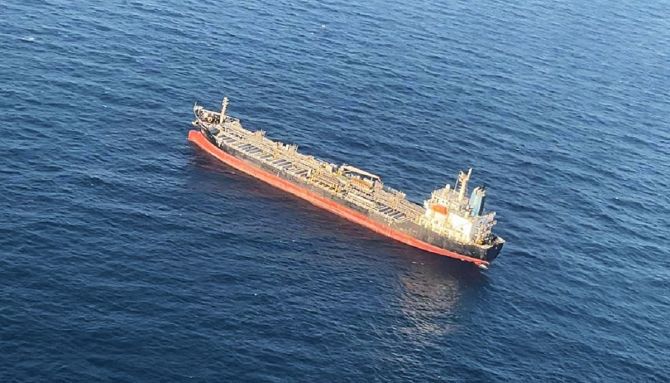
Preventive Measures against Surface Attacks
Commercial shipping under the aegis of the International Maritime Organization (IMO) had implemented certain preventive measures against attacks by pirates in the early 2000's which had proven effective.
Following measures were implemented by the IMO:
Best Management Practices
The purpose of Best Management Practices is to deter piracy and enhance maritime security in the Red Sea, Gulf of Aden, Indian Ocean, and Arabian Sea to help commercial ships to plan a safe voyage and to detect, avoid, deter, delay and report attacks at sea from pirates.
The latest being BMP5 which complements piracy guidelines in the IMO MSC circulars promulgated in www.imo.org and advice on the recommended measures whilst on passage through the Maritime Security Transit Corridor.
Key Focus of BMP5
- Risk assessment of the passage
- Voyage planning to ensure passage through dangerous waters in daylight hours.
- Information Security to avoid leakage of plans that can endanger the passage.
- Actions to be taken prior to entering the high-risk area.
- Briefing of crew and Bridge watchkeeping teams.
- Deployment of ship protection measures
- Rigging of physical barriers to prevent pirates from boarding the ship.
- Use of water sprays and foam monitors as a deterrent measure.
- Ensuring enhanced bridge protection against firing.
- Control of access to accommodation and machinery spaces.
- Identification and promulgation of safe muster points
- Use of citadels to ensure crew safety.
- Tactical use of lighting on the upper decks and keeping search lights standby.
- Deny the use of tools, equipment and protection of cargo stored on upper decks.
- Reporting of ship's movement to military organizations providing security in the area to improve situational awareness and their ability to respond.
Private Maritime Security Companies
The International Maritime Organization has permitted the deployment of private maritime security companies to protect the ship and crew whilst transiting through piracy prone waters.
The private maritime security companies may provide armed or unarmed services. The decision to employ them is with individual ship owners when permitted by the ship's flag State.
The BMP points out that companies must check the credentials and licenses/permits of the private maritime security companies to ensure that they have been issued by an appropriate authority and are operating legally.
Some flag States provide military Vessel Protection Detachments (VPD), the members being from the regular armed forces of the country.
Effectiveness of BMP
The above comprehensive measures have mitigated the piracy threat to zero during the last decade.
Recent incidents of piracy by non-State actors have underscored the effectiveness of these measures and the need to revive and follow them strictly to improve the security situation in the region.
Needless to state that ship owners and shipping companies must pitch in from their side to jointly counter asymmetric threat that is affecting shipping globally.
However, one needs to note that aerial threat from drones and missiles brings in a different dimension to the threat environment which warrants the need for naval ships and surveillance aircrafts/drones to counter the new challenges.
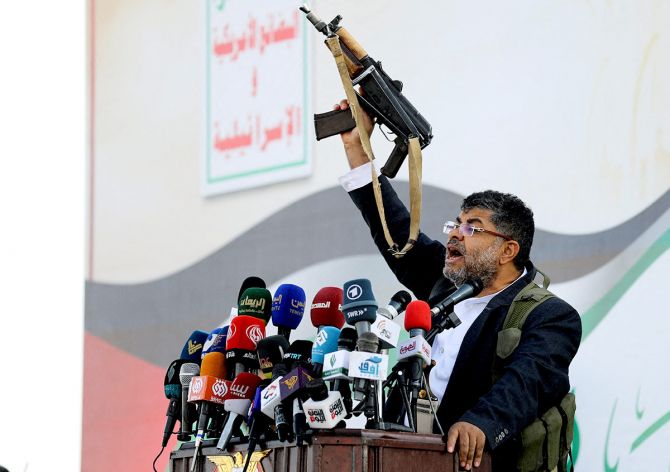
Role of the Military
Navies had been traditionally structured and trained to handle linear conflicts.
However, the maritime security challenges in the Red Sea have created a new dimension which has made a paradigm shift in wars at sea.
This has resulted in the need for the militaries to prepare to counter the new challenges.
I would like to highlight certain points which need to be factored in by the Navies to plan and tackle Low Intensity Maritime Operations/asymmetric warfare.
Recommended Measures for the Navies
- The Navies must be prepared for irregular threats by being able to distinguish them as they be operating in the backdrop of a complex environment of intra-regional, religious, and traditional rivalries. It includes the struggle between State and non-State actors for achieving legitimacy over the population.
- The need for a balance of naval forces for blue water operations as also for quick and deadly response to tackle asymmetric threats at sea.
These ships need not be high value platforms but should have good endurance, fuel efficiency, capable helicopter operations and good self-defence capabilities.
The design of the US navy's multi mission capable and Littoral Combat Ship (LCS) perhaps is the best suited to fit the bill due to its flexibility to adapt to mission requirements.
Offshore Patrol Vessels (OPV) operated by many Navies are also suitable for these operations. - Naval planning will also need to include decentralised small units operating with minimum logistics support with the capability to deploy swiftly and deliver a hard punch and disappear under the cover of stealth.
- Navies must factor in the threat from cyber warfare and incorporate suitable electronic counter measures.
- Maritime Domain Awareness is an important aspect for threat anticipation and evaluation where a target can be located, identified, and tracked with an effective network of sensors and the information gained should be transmitted to units by secure data links.
- Drones are ideal platforms to undertake surveillance missions at sea. Moreover, they can substitute maritime reconnaissance aircrafts which are earmarked for multi-task missions and may not be available for deployment.
- Special forces are highly skilled and trained professionals who play an important role in these missions. Normally they are embarked onboard one of the ships with their equipment to support the operations. They can also be para dropped to the scene of action at sea.
- A good intelligence network complements maritime domain awareness and plays an important role in asymmetric warfare.
Human Intelligence (HUMINT), Signal intelligence (SIGINT) and Electronic Intelligence (ELINT) are essential dimensions in these operations to understand the human activity and identification of entities and events.
Timely intelligence inputs on the intent of the enemy would give valuable inputs to the tactical commander at sea in his decision making. - Importance of an updated data base is a vital aspect to be considered in asymmetric warfare. The collated information should be passed on to the participating units prior to planning the operation.
- Maritime cooperation with the littoral/coastal States contributes immensely towards the success of the operation. Suitable ports in the area could be used for logistics turnaround.
- Success of these operations depends a lot on a joint approach as multiple units both surface and air belonging to different countries would be involved.
- Interoperability between Navies is vital, and this aspect needs to be exercised at every opportunity.
- The need for an effective command and control organiSation needs no additional emphasis. In the Red Sea and Gulf of Aden there are many naval forces operating under different umbrellas. The importance of a common grid and communication channel is paramount towards success of any maritime operation.
- Every operation has its unique characteristics and lessons learnt would differ considerably. It is important that navies document these inputs which would contribute to formulation of doctrines and standard operating procedures. These would come in handy towards planning and conduct of future operations.
- Navies need to practice the concept of Visit Board Search and Seize (VBSS) operations which was promulgated by the US navy in the early 2000s. This concept has been successfully proven during real time operations.
- Neutralising the command post of the adversary through subversion, direct attacks by air and by special forces can severely affect the morale of their organisation. An effective intelligence network is essential to pinpoint the locations of the targets.
Historically, wars in the maritime domain have been confined to the high seas with the use of regular naval forces.
The world needs to wake up to this new dimension of war at sea and be prepared to face the 'unknown enemy' who have the advantage of attacking at their choice of location and time.
In other words, wars at sea are heading for more complexity with the entry of non-State actors.
The aim of the adversary is to create panic, disrupt global trade and impact global economy.
I recommend a two-pronged approach to jointly tackle threat which would entail active participation of trade by adhering to best management practices in support of the coordinated operations undertaken by the navies.
A joint strategy would require greater coordination between the International Maritime Organization, vessel owners, shipping companies and the navies of the region to counter asymmetric warfare at sea.
Commodore Venugopal Menon served in the Indian Navy for 29 years in operational roles, including commands at sea, and training and staff assignments at Naval HQ.
In addition to the staff and war courses in the Indian Navy, he underwent the executive course at the Asia Pacific Centre for Security Studies, Honolulu.
Feature Presentation: Rajesh Alva/Rediff.com



